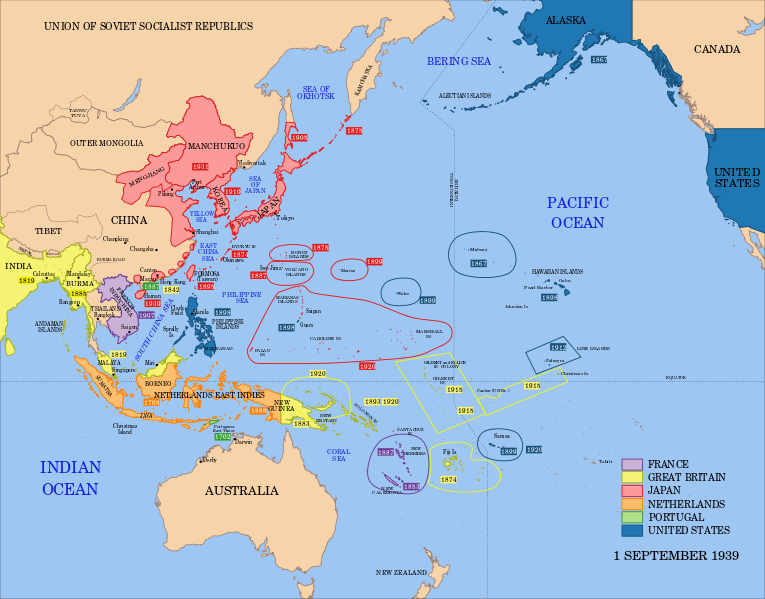JAPAN DROPS WAR PLANS AGAINST SOVIETS
Tokyo, Japan · June 30, 1941
On September 19, 1931, soldiers of the Kwantung Army (eventually the largest, most prestigious branch of the Imperial Japanese Army) invaded Manchuria in Northeast China from their base at Port Arthur (present-day Dalian or Lüshun Port) and established a puppet state they called Manchukuo. This event was a massive act of insubordination against the express orders of the political and military leaders in Tokyo. Suddenly thrown into disarray, the leaders were powerless to stop the eruption of locally based Japanese aggression in Northeastern China. Nonetheless, Tokyo dispatched reinforcements to Manchukuo from Japan and Japanese-held Korea and initiated large-scale “anti-bandit operations” to quell a growing resistance movement in the country’s newest possession.
For the rest of the 1930s Japanese military and civilian officials were of two minds: expand their imperial holdings west and north from their Manchukuo base by attacking Inner Mongolia (1933–1936 skirmishes), the Soviet Union (Siberia), or the Soviets’ proxy state, Outer Mongolia (present-day Mongolia) (1938–1939, decisive Soviet victories). Either that or expand south by attacking equally tempting Western colonial holdings in British Malaya and Singapore, the Dutch East Indies (present-day Indonesia), and the American Philippines (see map).
In July 1940 the Japanese government formally decided on a twin policy at least to the south of Manchukuo: first, win the existing war (since 1937) on China’s mainland by interdicting the lifelines that brought Western arms, munitions, and related materiel to their Chinese enemy; and, secondly, gain access to the desired raw materials from Malaya and the East Indies, if necessary by starting a new war in Southeast Asia. Toward the end of September 1940, Japan took the first step in implementing this plan and moved troops into the northern part of French Indochina (present-day Vietnam) by agreement with the German vassal state of Vichy France.
On this date in 1941 Japanese officials shelved any plans for expansion northward or westward from their Manchukuo base. Two days later, July 2, 1941, the Liaison Conference, consisting of senior Japanese government officials and Army and Navy general staffs, formally confirmed the decision to expand southward. This was the moment when war between Japan and the Western powers became inevitable.
Japanese and Western Holdings in the Asia Pacific Region, September 1939
 |
Above: A map of imperial possessions in the Asia Pacific region as of September 1939. The start of the Second Sino-Japanese War (1937–1945) was the inaugural event in World War II and arguably the deadliest, costliest global conflict ever. The total number of Chinese military and nonmilitary dead was upwards of 20 million, with maybe 15 million wounded. Additionally, Japanese “kill all, loot all, burn all” operations created 95 million Chinese refugees. Chinese forces claim to have killed at most 1.77 million Japanese soldiers during the eight-year war. The Pacific islands encircled in red lines (the Northern Marianas, Carolines, Marshall Islands, and Palau groups) are former German possessions under Japanese administration following World War I. They would play a major role in facilitating Japanese victories over the Allies in the early years of the Pacific War.
“Manchukuo: The Newborn Empire,” Japanese Propaganda Film, Circa 1937
![]()

 History buffs, there is good news! The Daily Chronicles of World War II is now available as an ebook for $4.99 on Amazon.com. Containing a year’s worth of dated entries from this website, the ebook brings the story of this tumultuous era to life in a compelling, authoritative, and succinct manner. Featuring inventive navigation aids, the ebook enables readers to instantly move forward or backward by month and date to different dated entries. Simple and elegant! Click
History buffs, there is good news! The Daily Chronicles of World War II is now available as an ebook for $4.99 on Amazon.com. Containing a year’s worth of dated entries from this website, the ebook brings the story of this tumultuous era to life in a compelling, authoritative, and succinct manner. Featuring inventive navigation aids, the ebook enables readers to instantly move forward or backward by month and date to different dated entries. Simple and elegant! Click 











